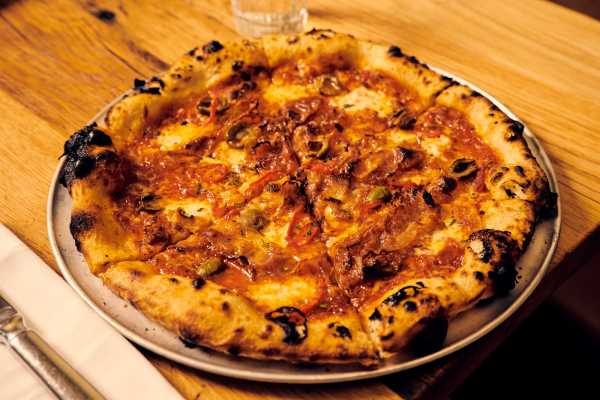
Save this storySave this storySave this storySave this storyYou’re reading the Food Scene newsletter, Helen Rosner’s guide to what, where, and how to eat. Sign up to receive it in your inbox.
Gjelina didn’t invent kale, or wood fire, or treating vegetables as the stars of a restaurant menu. But when it opened, in Venice Beach, in 2008, the restaurant certainly did bring all of those things together, in a package that jolted the restaurant world like a shot of gingerroot. The food served at Gjelina was not the California cuisine that had come before. The kitchen borrowed the ingredient worship of Chez Panisse, but not its reverence for simplicity; the fancy culture-mash pizza of Spago, but not its Eurocentric hauteur; the cheffy precision of the French Laundry, but not its fussy formality. The chef, Travis Lett, was obsessive about nearly everything—produce, sourcing, seasonality, herbs, spices, the chewiness of a hunk of sourdough or a pizza crust—and this obsessiveness resulted in a restaurant that was more or less flawless. Still today, stepping off the blazing L.A. sidewalks into the cool, rustic Gjelina interior feels like putting on a pair of full-body sunglasses. The enormous menu, printed in tiny type, gives an effect of shock-and-awe abundance. Nearly every plate is a showpiece for the triumphs of the prep kitchen: silken sauce, a house-made pickle, a zingy salsa, a curious ferment. It is, I’ll admit, one of my favorite restaurants in the world.

Many of the pizzas from the L.A. menu have carried over to New York.
An outpost of Gjelina in New York has been in the works for nearly a decade. It was first announced in 2016, as a partnership between the Gjelina team and the New York power restaurateur Ken Friedman, who at the time held the lease for the restaurant, a two-story space on a cobblestoned block in NoHo. Then a whole lot of things got in the way. Friedman became the subject of significant sexual-abuse allegations (he has denied engaging in nonconsensual activity) and left the project. A pandemic surged and ebbed. In 2023, just four weeks after an initial grand début, a fire ripped through the restaurant’s ductwork. In November, Gjelina New York finally reopened, though it was hard, all these years later, to muster the same giddy sense of anticipation I felt when it was first announced. Mostly, I felt a little vinegary that New Yorkers barely got to bask in the glow of having a Gjelina of our own before another one opened at the Venetian in Las Vegas, a few weeks later. Vegas, of all places! They barely even have farms there to hyphenate with “to-table.”

A pizza with guanciale, olives, and Fresno chile.
Is Gjelina, with its three locations, a chain now? It’s certainly more than just a restaurant. Lett left the Gjelina Group in 2019, selling his stake back to the founder, Fran Camaj (whose mother is the restaurant’s namesake). The company now operates a hotel, a takeaway, a home-goods store, a flower shop, and a foundation dedicated to vocational training in hospitality, plus Gjusta, a prepared-foods shop, which Camaj told The New Yorker he’s planning to bring to New York, too.
Though specific items on Gjelina’s menu have changed over the years since Lett’s departure, the kitchens, now under the stewardship of the executive chef Juan Hernandez, still hew to Lett’s philosophies and formulas. The dishes no longer feel as revolutionary as they did a decade and a half ago—pretty much everything that the restaurant serves could come straight from Lett’s “Gjelina” cookbook, from 2015, a terrific volume full of intimidatingly cross-referenced recipes and sub-recipes. But knocking off points for Gjelina’s continued dedication to Brussels sprouts and pestos is a little bit like dismissing “Hamlet” for being full of clichés.

The menu at Gjelina is defined by market-driven abundance.
The kitchen at Gjelina New York, naturally, is open, situated behind a dining bar, and is visually punctuated by the orange flames of a wood-burning oven. The food is just as striking, and just as assertive, as it is in California, with saturated flavors deployed in a calculated balance. A lush lamb tartare is spiced with North African baharat paste as resonant and lingering as a foghorn. A bouquet of long-stemmed broccolini is charred and frizzy around the edges and dressed in a vinaigrette just slightly softened by the tangy sweetness of black garlic. A twirl of saffron-infused spaghetti is tossed in a sauce of confited tomatoes and bottarga that burns with a red-chile heat. You order the roasted fennel because you love fennel; you close your eyes in rapture because of the onion agrodolce on top, which turns out to be what fennel has always needed, along with a sprinkle of togarashi, and a few perfect supremes of orange, for good measure.
One recent night, I counted fifty-two items on the dinner menu, not including desserts. The servers were not especially helpful at navigating the plenitude. “What sounds good to you?” seems to be their go-to phrase, and fair enough: when a restaurant has been doing its thing this well, for this long, there really is no wrong way to go. “Should we get the fingerling sweet potatoes, or the pinto potato?” my friend inquired on one visit, considering some of the spud options (four, including a pizza topped with thin rounds of potato, with taleggio and garlic). We went with the fingerlings—a row of blistered wedges with an edge of smoke and caramel, served in a pool of spicy yogurt under a shower of finely slivered scallions. What sounded good was indeed good; one of the promises of Gjelina is that what sounds good always will be.
What is different from the original, noticeably and significantly, is, in part, the physical space. L.A. sprawls; New York soars. This Gjelina is narrower, more vertical, a stack of boxy parlors with a scattering of street-facing windows and no fresh air to speak of. Sunny café vibes in a front room—pale wood, minimalist shapes—give way to moodier spaces inside: a large upstairs dining room, with the heavy wooden bar running along one wall; a quieter, upholstered dining area beyond that. At dinnertime, the restaurant is busy, but not slammed; the crowd seems to be largely made up of people with beautiful hair and compellingly hideous shoes. Compared with the L.A. Gjelina, the New York outpost, perhaps inevitably, has little sense of place.

The front room’s sunny café vibes give way to moodier spaces inside.
Back in February, when New York was gray with slush, I fled for a bit to California, and one afternoon ended up at the original Gjelina for lunch. It was that kind of magnificent Los Angeles winter day where the sky is Delft blue and the bright-white sunshine ricochets off every surface directly into your eyes. The restaurant was packed, as it always is, with a strikingly heterogeneous crowd—very old, very young, buttoned-up, bohemian. My two-year-old daughter made eyes at a tie-dye-clad kid of about the same age at an adjacent table. I eavesdropped unsubtly on a nearby trio of silver foxes. Our meal was in Technicolor: the ruby-reddest raspberries, the greenest-green cucumbers, the bloodiest-blood oranges, frilly purple mustard greens, carrots in every color of sunset. I felt drunk on fructose and chlorophyll; I kept pressing orange slivers of dried persimmon onto my utterly uninterested toddler: You don’t understand, it’s wonderful, you will love it.
A few days later and twenty-five hundred miles away, I attempted to re-create the idyll at Gjelina New York. You could put together a facsimile meal, if you wanted to—the broccolini with black garlic was on the menu at both locations, as were the roasted fennel, most of the pizzas, and a wedge of dense, fudgy chocolate tart dusted with pistachio. But, for all its nuance and verve, the food, over all, at Gjelina New York was simply less luminous than it had been in L.A.: paler, denser, more beige. Summer will be different, I know. The end of winter has already yielded fresh riches, such as puntarelle in a Caesar-ish anchovy dressing, and a pile of caterpillar-green new garbanzos next to a slick white ball of burrata. But eventually it’ll be fall again, and winter, full of sober root vegetables, and meanwhile at the sun-dappled Gjelina in Venice Beach they’ll be flinging strawberries around willy-nilly, free from the agricultural purgatory of temperate seasonality.
Helen, Help Me!
E-mail your questions about dining, eating, and anything food-related, and Helen may respond in a future newsletter.
Gjelina does fit seamlessly into its little stretch of Bond Street, which has become the epicenter of a certain strain of aestheticized wealth. Some clever cartographer has dropped a label on Google Maps identifying the block as LiLA—Little L.A. Down the street from the restaurant is Reformation, the hip L.A.-founded clothing line. A few doors past that is the Goop store; just beyond is the flagship of Gigi Hadid’s cashmere brand, Guest in Residence. But LiLA doesn’t feel like California on Bond Street; it just feels like a piece of New York that has a handful of California businesses paying rent. In Gjelina’s case, at least, the particularly Californian spark of organic, obsessive creativity seems to dull and cool as it’s mechanically reproduced in new locations: a plate of butter-basted oyster mushrooms that seemed to glow and sing over there just seemed, over here, like a pile of lovely mushrooms. A relaxed service style that felt friendly and chill in Venice felt, in Manhattan, spacey and unsteady. New York has never been chill, nor does it aspire to be. Its virtues lie elsewhere, in its density, its urgency, its perpetual churn. (L.A. has never really been chill, either, let’s be honest, but it does put on a convincing show.) Show up at Gjelina New York for breakfast and you might see a few copies of the day’s L.A. Times fanned out on a countertop near the host stand. Pick one up and look in on the goings on of a faraway elsewhere, a place where it’s always sunny, a place you might sometimes want to pretend to be. ♦
Sourse: newyorker.com







